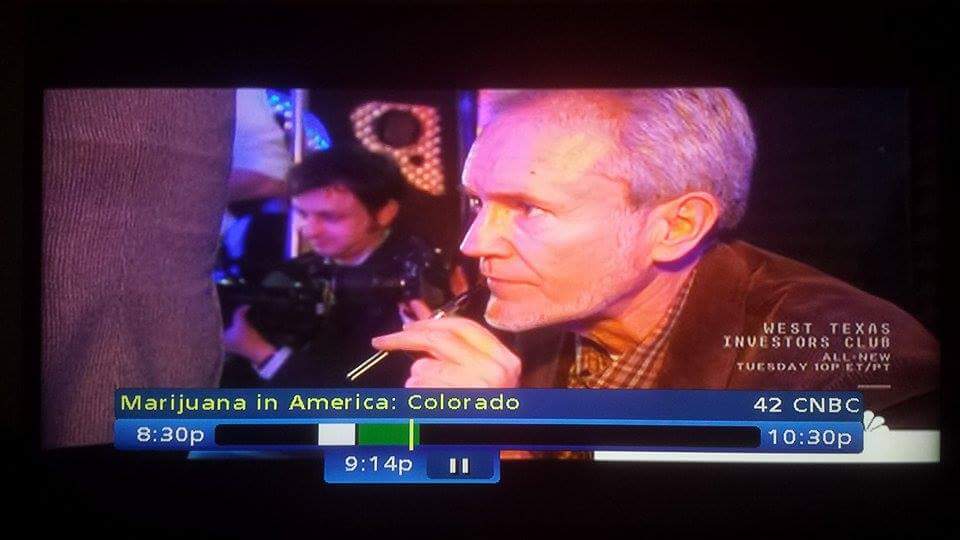This picture was taken on January 14th, 2014 by UK media at an “edibles” event at the Space Gallery, Downtown Denver. It was picked up by CNBC and was used as a teaser for their “Marijuana in America” series.

My former business partner and I were given complimentary tickets to this gala. At over a hundred dollars per, it was apparent that few of my patients would have been able to afford to attend.
But, this was new, a novelty. It was an evening of smiles and laughter and many, many selfies. The general hope was that this event was only the beginning of our new-found “legal” freedom. We were all quite hopeful…back then.
Even though it was an “edibles” event, the powers-that-be forbid the sponsoring Cannabis caterer, Jane West, from actually infusing the delicacies provided. As someone who has been infusing food for many years, I of course was quite disappointed. Though the food was all quite delectable, I had been looking forward to appreciating the tasty Cannabinoid nuances, prepared by the hands of a professional chef.
In consolation, a party bus was parked just outside on the street where we could imbibe (albeit vaping and smoking) amid a mixture of venders and press.
Even with the high cost of admission, it was a full house – mostly up and coming twenty and thirty somethings.
I was one of only a few gray-haired “oldies” that was attending, so, reporters flocked around for a “photo-op” with the “senior”. “Vape” vendors were continually at hand, eager to place one or more of their products in our hands, particularly if we were on camera…and there were A LOT of cameras!
Vape pens were and continue to be a fashionable convenience. Compared to smoking, the odor is much more confined, usually to just a few feet from the “puffer”. And it dissipates quickly, as vapors do. Unlike a pipe or a joint, the majority of the Cannabis product never reaches combustion. Instead the liquid is flashed into a mist. It’s too heavy to remain suspended for long, so it must be quickly inhaled.
Passing immediately into the bloodstream through the lungs, the effects are almost immediate.
It all seemed like the “next generation” in Cannabis use. So very far removed from the devices of MY generation. No pipes, papers, roach clips or ash trays. Vape pens were seemingly clean.
Of course, there were those rare moments when an overcharged battery would explode into a fireball in one’s pants pocket. There were reports of second and third degree burns, but hey, such is progress, right? Just part of the learning curve for a skyrocketing new revenue stream.

Many of us were well familiar with the concept of “vaping”, what with home models like Storz & Bickel’s “Volcano”, that would fill big plastic bags with “vapor”. Without reaching a combustible temperature, one could avoid the irritation caused by the carbon. It was a much more pleasurable experience with much more taste and much less coughing. For those of us with lung issues, it was a real game changer. A far more comfortable way to appreciate the bronchial dilating benefit of Cannabis – without the toxicity of prescription drugs like Albuterol.
But with the Volcano, that was vaporizing the naturally occurring oils in finely ground “flower”. It is a different matter entirely when vaporizing “concentrate”.
Cannabis “flower”, what most would think of when hearing the word “marijuana”, could typically contain from 10 to 20% THC, while concentrate could range up to and exceed 60%. More advanced methods could create products like distillates that could push that number up even higher.
Concentrate, as related to the “vape pens” of today, meant a liquid product, but also with much more concentrated levels of Cannabinoids – not just THC – because of the higher degree of refinement. A user could typically take one or two hits rather than a full pipe bowl or a joint for the same effect. It was usually a quick draw from the mouthpiece and back in the pocket before even an exhale. Easy to conceal…and didn’t make a mess, usually.
Back in the day, producing Cannabis concentrate meant cooking FECO, or Full Extract Cannabis Oil. Many still successfully battle chronic and terminal illness with oil produced that same, at-home way, with home-grown Cannabis and a food-grade solvent. A rice cooker or repurposed water purifier are commonly used to extract the alcohol.
But FECO doesn’t taste good when smoked. Largely because of the naturally occurring chlorophyll. It was food in its truest sense. Consequently, most understandably consumed it orally.
It wasn’t until much more sophisticated equipment became available that clean tasting, “honey” oils were possible. Unfortunately, that stepped beyond the means of most home-producers and caregivers.
But as we experienced with FECO, Cannabis concentrate can be quite viscous. I mean, we’re talking maple syrup consistency, or worse. Not something that adapts well to the necessary flow of a vape cartridge.
The shortcut would be to suspend the Cannabis concentrate in a “carrier oil”, a fatty liquid (because Cannabis naturally adheres to fat) that would dilute the Cannabis oil and make it more liquidy, thus easier to pull through a vape pen. And, for enterprising Cannabis product entrepreneurs, an opportunity to sell a diluted product for twice the price.
But this creates a problem. We know that Cannabis, even Cannabis concentrate can be absorbed safely through lung tissue when introduced in reasonable amounts, but that’s not necessarily the case when its mixed with a carrier agent.
Years ago, I was preaching the horrors of vaping Cannabis-infused cooking oils and vegetable glycerin, just as we’re hearing now in the media about the use of vitamin E acetate (tocopherol acetate) – again as a carrier agent.
Vitamin E acetate is actually a very well known nutritional supplement. It is often used in skincare products. Oral and topical applications of vitamin E have proven to have considerable medicinal benefit – when consumed properly.

What can safely be consumed orally or topically may not be safe for sensitive lung tissue. The problem is that these substances are not absorbed like Cannabis concentrate. Instead, particularly when subjected to heat, they adversely coat lung tissue. Long, deep hits, as is customary among Cannabis consumers, means even the more remote parts of the lungs can get a layer of this sticky substance, compromising even more of that which is so necessary for oxygen absorption. The effects are quite literally, COPD (Cardio Obstructed Pulmonary Disorder), emphysema.
They say it burns. Understandably so with Vitamin E Acetate. The lungs become inflamed, as the body struggles to clear or isolate the substance corrupting the lung’s purpose. If it cannot be absorbed or expelled, it more than likely will mean permanently reduced or lost function.
It is possible to produce vape cartridges that don’t require a carrier agent, at least when we’re talking about Cannabis. But it’s more expensive, AND, it doesn’t allow the unscrupulous to conceal their diluting.
And something else. Particularly when we are talking about CBD or hemp oil. Cheap, knock off vape cartridges are often produced with CBD paste imported from places like China that don’t concern themselves with the ramifications of selling product contaminated with toxic chemicals, insecticides and heavy metals. A few years ago, we assisted those who sought to identify unscrupulous merchants generating poison for product.
My hope is that you’re beginning to realize the caliper of an individual who would carelessly or worse, intentionally produce a product as dangerous as this, purely for the sake of profit. Believe me when I say that you don’t have to leave the country, or the state of Colorado, for that matter, to encounter many who value your money far more than your health…or your life.
Here we have something incredibly healthy that people can safely consume, that actually can heal them of terrible disease. Why on earth would anyone want to do as the pharmaceutical companies and turn healthy, nontoxic remedies into toxins?
What’s in them?
Through the years, I have quizzed a number of vendors and many “budtenders” about the contents of their vape cartridges. All but one had no idea what was in their cartridges. Most were peddling products with no concept of their safety. How much worse when we’re talking about convenience marts and liquor stores selling nicotine and CBD cartridges -all over the country – utilizing the same or similar carrier agents?
The tobacco industry was quick in their attempt to blame consumer lung damage on Cannabis, even when the products were largely nicotine infused. The media had no problem echoing that sentiment, even after vitamin E acetate was identified as the culprit. Cannabis has always been an easy target.
Buyer beware – but please, amid the hysteria, let’s not react by punishing the consumer and patient with further obstruction to Cannabis access, when education and sensible consumer protection can work far more efficiently. And in so doing, still protect the rights of the consumer and needful patient.
We must insist that those who draft our laws truly understand that it is not Cannabis that has the potential for harm, but rather that which is mixed with it.
Cannabis is nontoxic. Cannabis is food. Cannabis is the single most important medicine of the 21st century.
#cannabisrestoration

